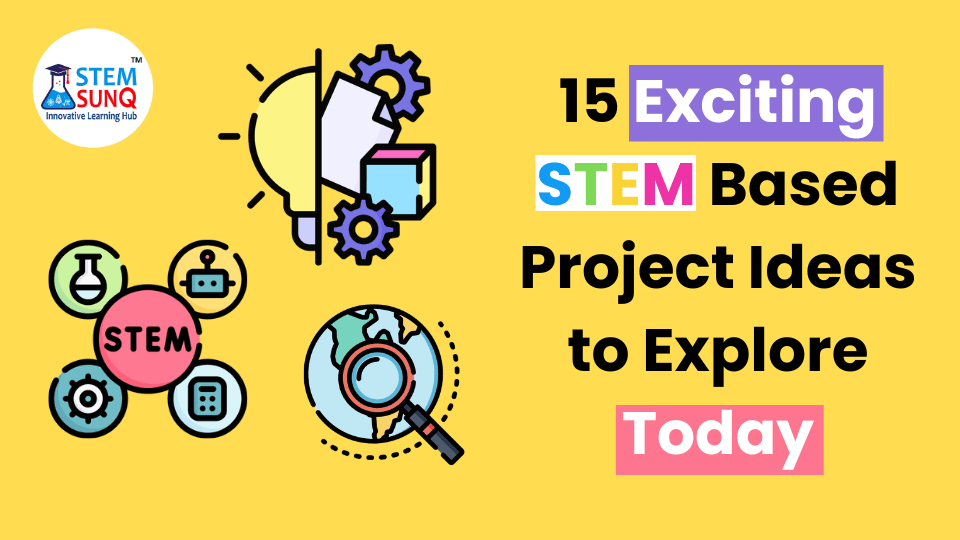Innovative Learning Hub

STEM project-based learning (PBL) is an engaging method of instruction in which students actively participate in projects from the real world. They work on practical projects such as making robots, studying ecosystems, or resolving environmental problems rather than memorizing information. PBL boosts imagination, teamwork, and critical thinking, bringing STEM concepts to life. So in this blog post, we will know 15 exciting stem project based ideas. It’s all about understanding how science, technology, engineering, and math are used in real-world situations and learning by doing. In short, it links what is learned in the classroom and what happens in real life, creating a passion for STEM.
Here are the powerful benefits of project-based learning knowledge of real-world applications which helps to learn critical thinking and problem-solving improved ability in teamwork, collaboration excitement, involvement of the students supports creativity and innovative learning effective communication skills Continuous interest in learning.
Now let’s know the 15 exciting stem project based ideas
Designing and developing solar ovens allows students to gain insight into the world of sustainable energy. While cooking and playing with solar heat, they will learn about using the sun’s energy for useful purposes. Explore STEM-based Solar Science activities.
In this project, students explore ways to preserve the environment by creating a sustainable model ecosystem. They’ll think about how to reduce waste, save resources, and create an energetic ecosystem.
This project combines robots and space exploration. Students can create Mars rover models and perform trips to investigate the surface of the planet, with a focus on problem-solving and creativity.
Students can learn about biodiversity by conducting a biodiversity study in a nearby park or natural area by doing this project. They will learn about many animals, ecosystems, and conservation activities.
Students gain not only coding abilities but also a sense of social responsibility. They create apps to address community challenges while encouraging creativity and technical problem-solving.
Students develop creative works while investigating 3D modeling and printing. In addition to learning about the possibilities of additive manufacturing, they get hands-on learning experience with cutting-edge technologies.
Students gain knowledge about the value of clean water through this activity. They experiment with ideas related to environmental science and water purification as they design and build water filtration gadgets.
Students can promote green energy alternatives in their neighborhoods by planning an event displaying renewable energy projects. While increasing sustainability, they will develop their event organizing and presentation skills.
build-up and run a hydroponic gardening system to teach themselves about how plants grow without soil. This project addresses modern methods of farming by merging biology, agriculture, and technology.
Students design and manufacture small electric vehicles to encourage environmentally friendly transportation. They can explore electrical engineering and social responsibility by designing their eco-friendly mode of transportation.
Students can gain knowledge of weather and climate science through their creation of a weather monitoring station. They’ll gather and examine meteorological information, promoting scientific research.
In this collaboration project, Students practice who lives in space. They will look at collaboration, space science, and the challenges of surviving and working in a small, remote area.
This project will teach students about coding and game design. They make educational video games that encourage students to think critically and creatively while also improving their ability to use technology.
By designing and building model bridges, students understand structural engineering fundamentals. They get a firsthand understanding of construction procedures and material qualities.
This project examines the topic of genetic engineering. Students undertake biotechnology studies in which they explore themes such as DNA modification, gene expression, and genetic features.
Also, read why DIY project offers valuable benefits
To choose a project based learning (PBL) topic first begin by thinking about your personal STEM interests and making sure they match with your school’s needs. Then, research other ideas, analyze their feasibility, and come up with a clear purpose for your project. Remember to seek advice from your teachers and collaborate with other students to gain more insights. Finally, choose a topic that truly interests you, develop a project plan, and remain flexible as you discover more about the topic you chose during the project.
No, STEM and PBL are not the same. STEM stands for Science, Technology, Engineering, and Mathematics, and it refers to a group of academic fields that involve these topics. On the other hand, PBL, (Project-Based Learning), is a method of learning that uses projects to teach students these topics. PBL is a form of instruction that can be used to provide STEM education, but they are not the same thing. STEM fields are defined, but PBL is a teaching and learning method.
STEM projects for kids are hands-on activities that combine Science, Technology, Engineering, and Mathematics to support learning through research and creativity. These projects expose students to real-world problem-solving situations while also developing creative thinking and teamwork. They can include developing, exploring, coding, and other activities that make learning enjoyable and relevant. STEM projects for kids are designed to pique their interest and prepare them for a lifetime of creativity and discovery.